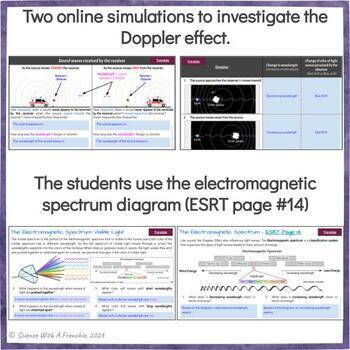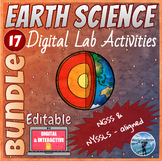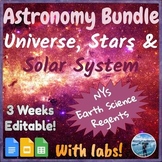The Doppler Effect - Evidence for the Big Bang Theory | Digital Lab Activity
- PDF
- Google Apps™

What educators are saying
Also included in
- These digital Earth and Space Science lab activities are ideal for topics where hands-on lab activities may be difficult to complete. They are aligned with NGSS and the New York State (NYS) Earth Science curriculum to prepare the students for the Regents exam. All the labs are editable and interactiPrice $43.50Original Price $57.50Save $14.00
- This astronomy bundle covers everything your students need to know about the Universe, Stars, and the Solar System for the New York State (NYS) Regents exam. It includes guided notes with practice questions, teacher presentations, 3 digital and interactive lab activities, and 3 self-checking digitalPrice $33.20Original Price $41.50Save $8.30
Description
In this Google Slides™ digital lab activity, the students will learn how the Doppler effect is used to measure the movement of galaxies and stars in space and why the redshift in the light from distant galaxies is one of the pieces of evidence for the Big Bang Theory. The students will analyze light spectra from galaxies and stars. They will notice a pattern in the relationship between the position of the absorption lines with respect to the red end of the electromagnetic spectrum and the distance of galaxies. The students will notice that most galaxies in the Universe are moving apart, indicating that the universe is expanding.
This is an interactive lab activity with links to online simulations, videos, and drag-and-drop features. The students will use two simulators to analyze sound and light waves between a source and an observer during different scenarios of relative movement. There is also a BrainPop video (in English or in Spanish) to provide some background about the atmosphere to the students. BrainPOP requires a subscription; however, if your district doesn’t have one, you can find the video on YouTube.
ESL Strategies: This lab activity is scaffolded for English Language Learners (ELLs):
- Each slide contains a “Translate” hyperlink button to translate the text into any language supported by Google Translate.
- It includes sentence starters to help ELLs structure their answers. The document is editable so you can remove the sentence starters if your students don’t need them.
- The videos are in English and Spanish. Please note that some videos may be different for the different languages; however, the concept they cover is similar.
Standards: The level of this lab is perfect for 8th grade or high school. This lab activity aligns with:
- NGSS HS-ESS1-2: Construct an explanation of the Big Bang theory based on astronomical evidence of light spectra, the motion of distant galaxies, and the composition of matter in the universe.
- New York State Physical Setting/Earth Science Core Curriculum 1.2a - The universe is vast and estimated to be over ten billion years old. The current theory is that the universe was created from an explosion called the Big Bang. Evidence for this theory includes a redshift (the Doppler effect) in the light from very distant galaxies.
- NYS Regents skills: The students will use the electromagnetic spectrum diagram on page #14 of the Earth Science Reference Tables (ESRT).
Editable: You can edit the text of this lab activity by clicking on “View” → “Theme Builder”. However, due to Term of Use agreements with clip art artists, some of the background images aren’t editable.
Digital: This digital lab activity was created with Google Slides™ . It can be used in person or for distance learning. Share the Google Slides™ with your students via your Google Classroom. Make sure you select “Make a Copy for Each Student” while you are creating the assignment.
Astronomy Reviews:
⭐ The Electromagnetic Spectrum | Digital Review Activity | FREE
⭐ HR Diagram & Characteristics of Stars | Regents Review | Digital | ESRT page 15
⭐ Planets of the Solar System | Regents Review | Digital | ESRT page 15
⭐ Astronomy Vocabulary Review | Color by Number
⭐ Astronomy Task Cards | Earth Science Regents Review | Digital
⭐ Winter Holiday Earth-Sun-Moon System Task Cards | Digital Review Activity
Astronomy Digital Lab Activities:
⭐ Life Cycle of Stars | Digital Lab Activity
Notes & Workbooks:
⭐ Universe & Stars Notes and Workbook | Astronomy Unit | Editable
⭐ The Solar System Notes and Workbook | Astronomy Unit | Editable
⭐ The Earth-Sun-Moon System Notes and Workbook | Astronomy Unit | Editable
Bundles:
⭐ Astronomy Notes for NYS Earth Science Regents | Editable
⭐ Astronomy Bundle - Universe, Stars & Solar System
⭐ NYS Earth Science Vocabulary Reviews | Color-by-Numbers
⭐ NYS Earth Science Digital Lab Activities | Growing Bundle
⭐ NYS Earth Science Digital Regents Reviews | Growing Bundle
Follow me for notifications about new resources coming soon!
Find me on Instagram!







